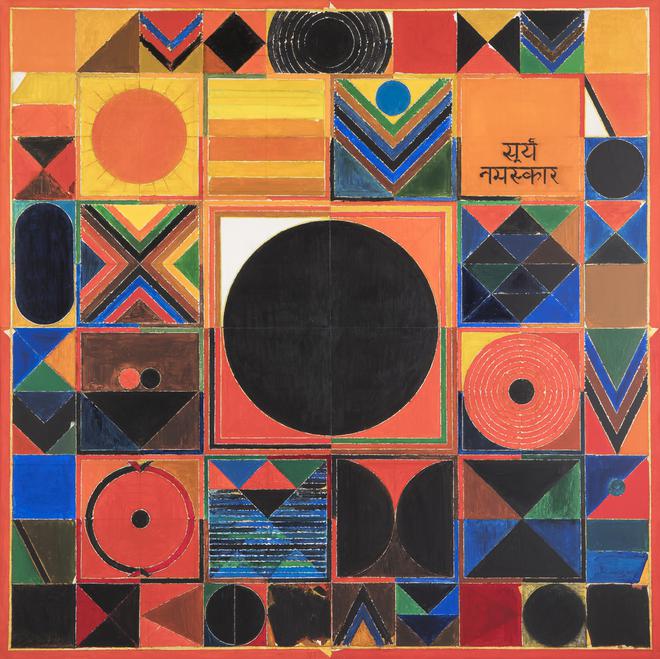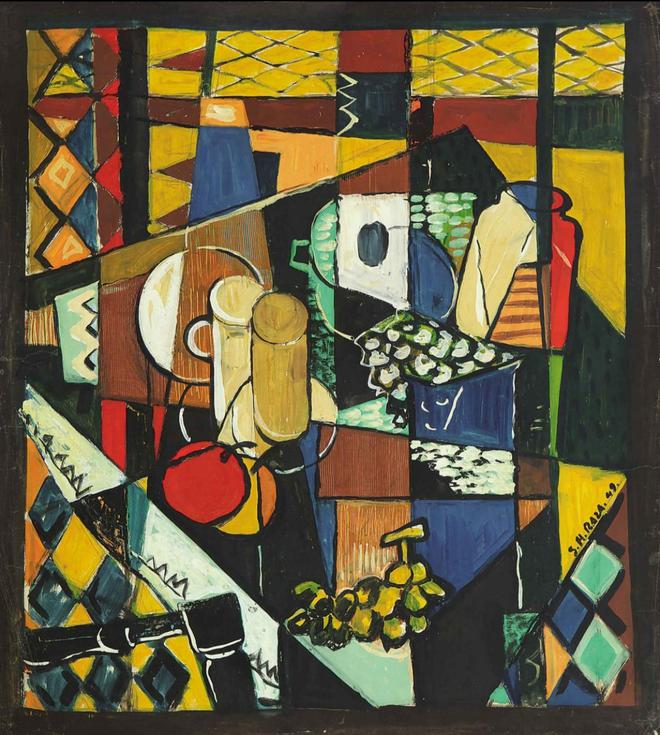‘Raza was secular, with a global outlook’
Curator Ashvin Rajagopalan, who is writing a book on SH Raza’s Bombay years, on why this generation can’t afford to forget the artist
Curator Ashvin Rajagopalan, who is writing a book on SH Raza’s Bombay years, on why this generation can’t afford to forget the artist
It’s funny that I’ve never met the man I’m obsessed with. The only time I saw SH Raza was for a couple of minutes in 2015, a year before he died, at the India Art Fair, when he dropped by to see our curation of Krishen Khanna’s work. He came in, I took a photo, and he left. It was like an ‘if I had run into a celebrity’ moment.
I believe we cannot forget Raza because his contribution to modern Indian art is being fully understood only now. He had a 73-year-long career, from 1943 (when he officially started to call himself an artist working in Bombay) to 2016. And in that time, among the many things he’s taught us, are two important points.

Surya Namaskar
| Photo Credit: Piramal Art Foundation
First, his secularism. He came to Bombay a year after the Quit India movement launched in the city. Raza saw both the protest and the result, which is very rare. (We often have to wait decades to see the result of our protests.) Raza was involved with all the key players — with Mulk Raj Anand and the progressive writers, and Ebrahim Alkazi and the progressive theatre group. He was at the forefront of artistic protest. But through it all, he maintained his secular outlook. He is the ultimate example of what India can do.
Second, his global aesthetic. Art in India — other than indigenous forms like miniatures, Tanjore paintings, kalamkari, etc — is western academic art. The idea of the canvas, oil paints, exhibitions, galleries, everything is western. In that context, Raza realised he was learning modern art second hand, and he wanted to go to the primary source. So he went to Paris and in 1956, won the Prix de la Critique — a critics’ award, which is a high honour, much like the BAFTAs (and not the Oscars). He was the first non-French person to get it.

Ashvin Rajagopalan
| Photo Credit: Piramal Art Foundation
Raza constantly pursued a global understanding of modern art. He opened a gateway and created a continuous dialogue between people in India and Europe. This is a lesson young artists today should learn. You may paint something that resonated with you in your village, but how will I explain it to a collector in Mumbai, Iran or London? You should learn to expand your ability to communicate beyond your own little bubble. That’s why a Picasso resonates with the world. Or a Raza. They speak a global language. You don’t need to explain circles and squares and tantra and bindu.
In the Louvre in Abu Dhabi, there is a Mark Rothko hanging immediately next to a Raza. It says that here are two artists who dealt with very similar concepts, and anybody in the world can understand them.
The exhibition at Piramal Museum of Art
| Photo Credit: Piramal Art Foundation
Passion project
Finding a calendar for Swedish company Volkart Brothers, from 1947 — with each month featuring a painting by Raza — triggered a large research journey for me. I realised that much of the years he stayed in Bombay, he was employed as a commercial artist. Many don’t know this. So I began looking into his Bombay years, and it is turning out to be a full book (which I have been writing for two years now and I hope to complete in another three months). I am telling a story; an almost day-by-day recall of what he did between 1943 and 1950. And all of it is new research.

Raza’s work that resembled Picasso’s
| Photo Credit: Piramal Art Foundation
I have literally gone through seven years of newspapers at the Maharashtra State Archive, reading every ‘Today’s Engagement’ starting January 1, 1943. If it mentioned Raza’s name somewhere, like an exhibition of his work at the Bombay Art Society (which he would have attended in person because he was living in the city), then I would look at what else he would have discovered the event. This is how I know that he saw an exhibition that MoMA had sent down in 1947 of Picasso’s work. In 1949, Raza painted a work that was very similar to one of Picasso’s pieces exhibited then. It’s been such Sherlock Holmes moments.
As told to Surya Praphulla Kumar
Ashvin Rajagopalan is director of Piramal Art Foundation, Mumbai, and Ashvita’s, Chennai. A new exhibition curated by him at the Piramal Museum of Art showcases over 40 works (1944 to 2005) that trace Raza’s artistic development — from his formative years in Bombay to when he became world renowned.
For all the latest Entertainment News Click Here
For the latest news and updates, follow us on Google News.
